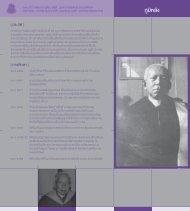Create successful ePaper yourself
Turn your PDF publications into a flip-book with our unique Google optimized e-Paper software.
62MelendresDeCorse 2005; Renfrew and Bahn 2000; Thomas and Kelly 2006). Thisceramic collection culture has been present in the Philippines since theearly 20 th century (Beyer 1947; Evangelista 1960; Locsin and Locsin 1967;Mijares 1998). With the increasing interest in archaeological techniquesand the development of methodological or scientific approaches toarchaeology, studies on artefact analysis such as ceramics haveprogressed and advanced beyond antiquarianism (Gibson and Wood1990; Rice 1987; Sinopoli 1991).One of the types of ceramics that particularly interestarchaeologists in Southeast Asia is what is known as “oriental tradewareceramics”. Oriental tradeware ceramics have long been valued objects inthe interactions of cultures between China and Southeast Asia and alsobetween China and polities farther west (Wang Gungwu 1998). In theseareas, ceramics were in great demand. As an artefact of foreign origin toNanhai polities (Andaya and Andaya 1982) such as Philippines andIndonesian cultures, Legeza (1978) noticed that tradeware ceramics ofhigh-fired, resonant and glazed stonewares and porcelains originallyembodied an alien and intrusive facet in the multi-layered indigenouscultures. But these polities were remarkably receptive and acquiescent tothis intrusion and adopted the utilisation of these new materials.Some of the trading partners of the makers of oriental tradewareceramics were located in the Philippines. Because of this, the Philippinearchipelago is well known for archeological sites with cornucopia oforiental tradeware ceramics both on land and shipwrecks (Beyer 1947;Locsin and Locsin 1967; Orillaneda 2008). Due to the dearth of writtendocuments or accounts, the emergence of oriental tradeware ceramicstogether with indigenous cultural material found in early Filipino burialsites and habitation sites, as well as shipwrecks, serve as guideposts in thereconstruction of the movement, intensification, and development of earlyPhilippine polities.The analysis of oriental tradeware ceramics in the Philippines isnot standardised. Most of the time, the identification is done and acceptedwithout question because of the stature and name of the analyst or theperson who identified the ceramics. This paper proposes a system ofdetermination which allows non-specialists to learn how to analyseoriental tradeware ceramics and at the same time shows the basis of theidentification of these wares. It will also review how oriental tradewareceramics are studied and analysed in the Philippines before this proposalwas developed.



